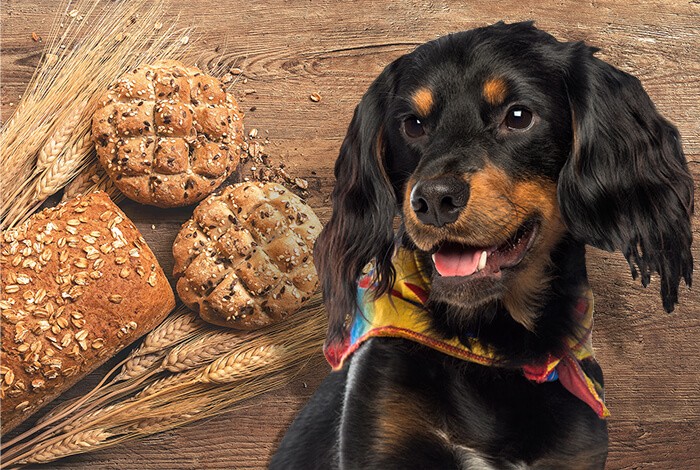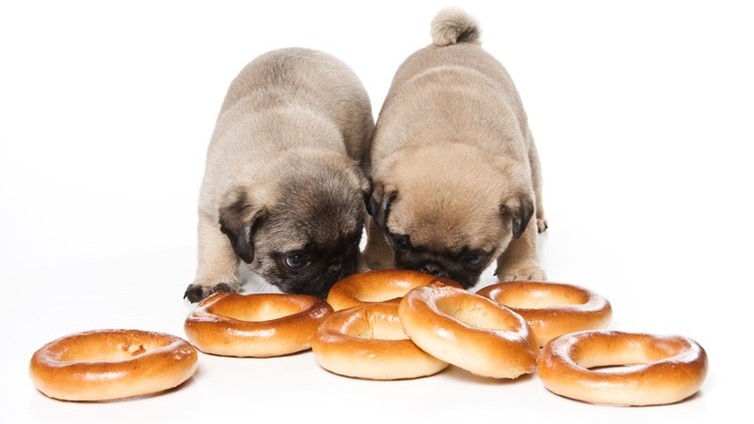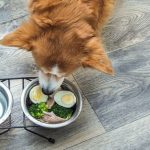Bread is a staple of the human diet, and most of us consume it at some point every day. As a dog-loving nation, we love to share everything with our dogs, so have you ever wondered if bread is a healthy snack for your dog? Answer: Yes, plain bread with no added ingredients is not toxic to dogs. However, it does not provide them with any nutritional value. However, in some cases, bread can be very toxic to your dog. This guide will tell you everything you need to know, from dog-friendly bread to the types to avoid.
Can Dogs Eat Bread?
Dogs can eat small amounts of plain white or brown bread, but only occasionally. There are some types of nuts that can be toxic to your puppy and will contain extras like nuts – macadamias are toxic and all nuts are high in fat which is not good for dogs. Additionally, bread that contains chocolate chips, raisins, onions, garlic, and some dessert pieces of bread may also contain xylitol, so be sure to double-check the ingredients first.
While dogs can eat bread, we do not recommend it as it is not good for them. If you really want to give your dog a bit of bread, the bread has to be plain, a small amount, and it should be a special treat. It’s important to remember that treatment should only make up 10% or less of your dog’s diet and that treatment should always be given in moderation.
Related Post:
Can Puppies Eat Adult Dog Food?
Can Dogs Eat Eggs?-Is It Good For Dogs To Eat Eggs?
Can Dogs Eat Oranges?-Why & How
Is Bread Good or Bad for Dogs?
Bread is as delicious as bread to us humans, the question of whether it is “good” or “bad” depends on each individual’s dietary needs, preferences and allergies. The same applies to our canine companions.
While bread isn’t bad for dogs, it’s generally not recommended unless it may have medical benefits, since dogs aren’t meant to digest bread.
How Much Bread Can Dogs Safely Eat?

While some of us might enjoy sitting on a slice of bread for a snack at a time, it’s a whole different story for our canine companions.
Regular feeding of bread can also cause your dog to gain weight. A slice of bread, depending on the variety, is usually 100 calories. It’s a good idea to keep your dog’s size in mind and divide it proportionally.
What Kinds of Bread Can Dogs Eat?
There are dozens of different types of bread. This is great news for us, but can be confusing when it comes to being able to feed our pups. But fear not.
Dogs can safely eat plain white, wheat, and rye bread. However, it is important to avoid the following ingredients in bread: nuts (especially macadamias), chocolate, grapes and raisins, onions, garlic, and xylitol. Here are the dos and don’ts for all types of bread:
Garlic Bread: Garlic is toxic to dogs and can cause damage to red blood cells. While garlic bread is delicious for us humans, it’s a big no-no for dogs.
Whole-wheat bread: Whole-wheat bread is generally safe as long as it’s plain.
Banana bread: Banana bread is safe if it doesn’t contain a lot of sugar, butter, or toxic ingredients like chocolate chips, nuts, or xylitol.
Sourdough bread: Due to the presence of yeast, sourdough bread is not a safe option for dogs.
Rye Bread: If rye bread contains no potentially harmful ingredients, you can share a few bites with your dog companion.
White Bread: White bread is another safe bread to share with dogs!
Can Dogs Have Uncooked Bread Dough
According to the American Kennel Club, raw bread dough can be harmful to dogs. Interestingly, their stomachs provide ideal conditions for the dough to ferment, and when they eat the dough, the dough expands and distends their stomachs and releases toxic ethanol into the bloodstream, leading to alcoholism.
Do not feed undercooked bread dough to your dog, and contact your veterinarian immediately if your dog swallows any bread dough and you notice any of the following symptoms after your dog has eaten bread dough:
- Elevated heart rate.
- Weakness
- Unsteady gait – may look almost “drunk”.
- Bloating.
- Depression
- Seizures.
- Respiratory failure.
- Low blood pressure.
- Retching or vomiting.
- In severe cases, your dog may fall into a coma.
How To Feed Dogs Bread?

Our advice is to avoid feeding your dog bread. While it’s available as a small-dose treat, it won’t do your dog any favors, and in some cases, the bread contains potentially harmful ingredients. Instead, choose to eat healthy dog meats, such as fresh vegetables and cooked lean meats.
It’s also important to remember that our dogs are not like us.
It’s common for us to eat a slice of dry toast to relieve an upset stomach, but it doesn’t do the same for dogs. If your dog has an upset stomach, bland boiled chicken breasts and rice are best, but be sure to contact your veterinarian for advice before trying home remedies.
Bread and Dogs
Veterinarians do not consider most bread to be toxic to dogs. The dog’s trouble is its ingredients, ingredients, and edible form.
Dogs need a high protein diet. They are facultative carnivores (some consider them omnivores), which means they can digest both plants and proteins, as long as protein is a major component of the daily diet.
As dogs have evolved from their ancestors, their digestive systems have barely changed. Their bodies still need high protein, low fat and carbohydrates, and very few grains.
- When excess carbs turn into sugar
When the ancestors of modern dogs ate too many carbohydrates and fats, their bodies stored them for energy when food was running low. In domestic dogs, these excess carbohydrates are also stored. However, since our dogs eat regularly, these carbohydrates can build up and cause weight gain.
Bread is a high carbohydrate food. Its carbohydrates are converted into sugar (energy) in the body. If you feed your dog a well-balanced and healthy dog food and give them enough exercise, then there is no need to feed them bread as a regular part of dog food or dog food.
- Bread and cavities
The sugars in bread can wreak havoc on a dog’s teeth as they stick to the teeth and gums. Sugar attracts bacteria to the teeth, leading to cavities. As tooth decay develops, it becomes periodontal disease. Veterinarians and studies have proven that most dogs develop dental disease by the age of three.
- Wheat Allergy and Gluten
Wheat bread contains gluten, which many dog parents try to avoid. Some dogs may be allergic to wheat, although veterinarians consider wheat bread to be a healthier option for your dog. If your dog is allergic to wheat, you can offer them bread made with rice or coconut flour.
Eating too much bread can lead to weight gain
White bread can relieve stomach pain or adhesions to foreign bodies. But eating too much can lead to weight gain, which can lead to obesity, heart disease, high blood pressure, and joint pain.
Summary
In short, sharing a piece of toast or a sandwich won’t hurt your dog. Just know that bread is a human food and has no health benefits or nutritional value for your tail-wagging person’s balanced diet. Occasionally eating foods free of harmful ingredients is fine, and your puppy will happily share yours. Just remember that anything more than a little bit can affect your dog’s overall health. In short, sharing a piece of toast or a sandwich won’t hurt your dog. Just know that bread is a human food and has no health benefits or nutritional value for your tail-wagging person’s balanced diet. Occasionally eating foods free of harmful ingredients is fine, and your puppy will happily share yours. Just remember that anything more than a little bit can affect your dog’s overall health.





